Mars Opposition 2022
A blog of all posts for the 2022 Opposition
Mars Opposition Blog 4 December 2022
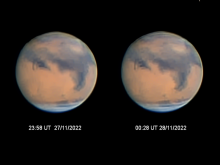
With opposition nearly upon us, the dismal UK weather has not been helping our programme, with rain and cloud prevailing for more than the last fortnight. Under such circumstances, every little helps. I draw your attention to the points mentioned in the last blog post.
Since the last update the total number of observers has risen to 80. We have added a Word document listing all these contributors to the front page. This will be updated from time to time.
The Martian atmosphere has continued to be relatively clear. Detailed images and drawings have been received, and many fine details can be seen. David Graham had a fine view on Nov 28, as posted here.
Within the S. polar region, some of the better images have shown faint, E-W orientated belts of white cloud. These have been observed at the end of S. summer in the past. See the images by Peter Tickner on Nov 27-28 and by Gary Walker (USA) on Nov 29.
In the north, the variable N. polar hood has gradually shown less and less activity, and signs of contraction. It continued to veer further south in certain longitudes such as Mare Acidalium, and to show partial transparency there; see the images by Mark Radice on Nov 18 and by Robert & Sophie Stuart of Nov 19. Massimo Bianchi, the Coordinator for the Unione Astrofili Italiani, has sent me some fine images by his contributor Marco Lorenzi of Singapore: the image of Nov 26 is posted here, and may show the edge of the ground cap.
We have seen a small dust event around Nov 23-24 at Chryse Planitia (south of Nilokeras), and I thank Makoto Adachi for alerting me to Japanese observations of it, and to Mike Caruso (USA) recognising it upon his own images, one of which (Nov 24) I post here. It was also nicely imaged as a bright yellow spot by Frank Melillo (USA) on Nov 23. There have also been a number of small dust events at the edge of the NPH.
Finally, we must not forget Phobos and Deimos. In spite of the planet’s low altitude as viewed from Australia, Anthony Wesley captured both of them on Nov 20.
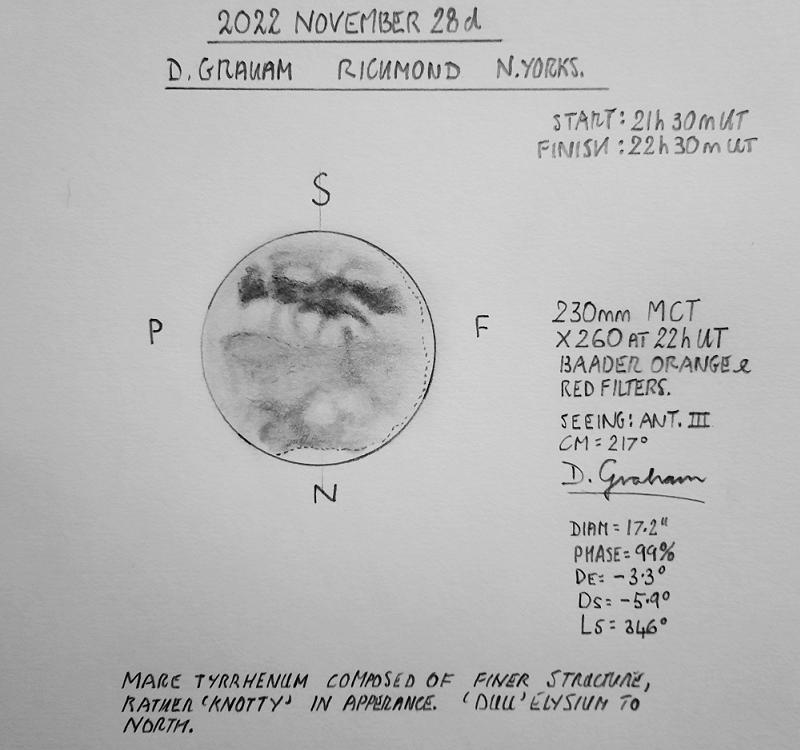
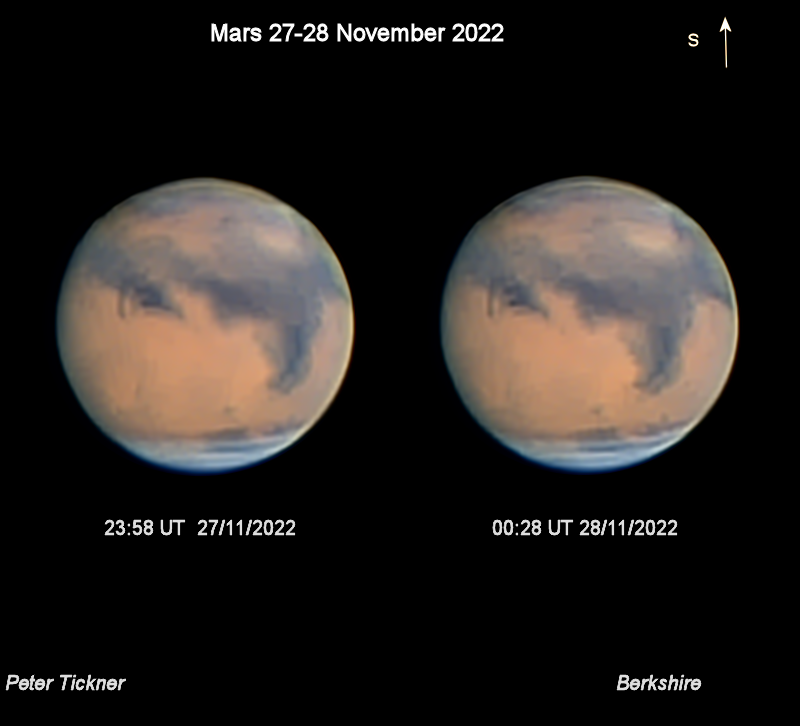
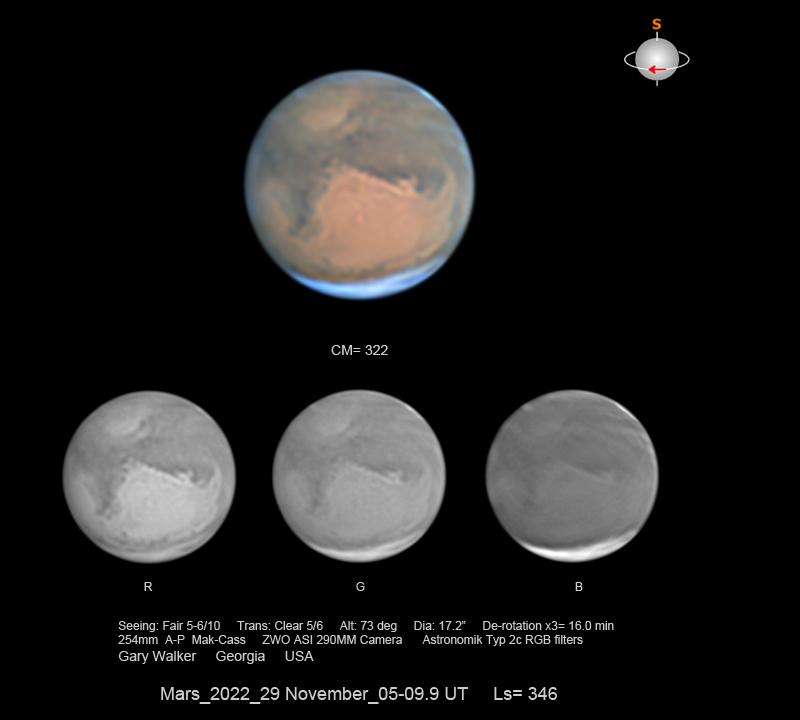
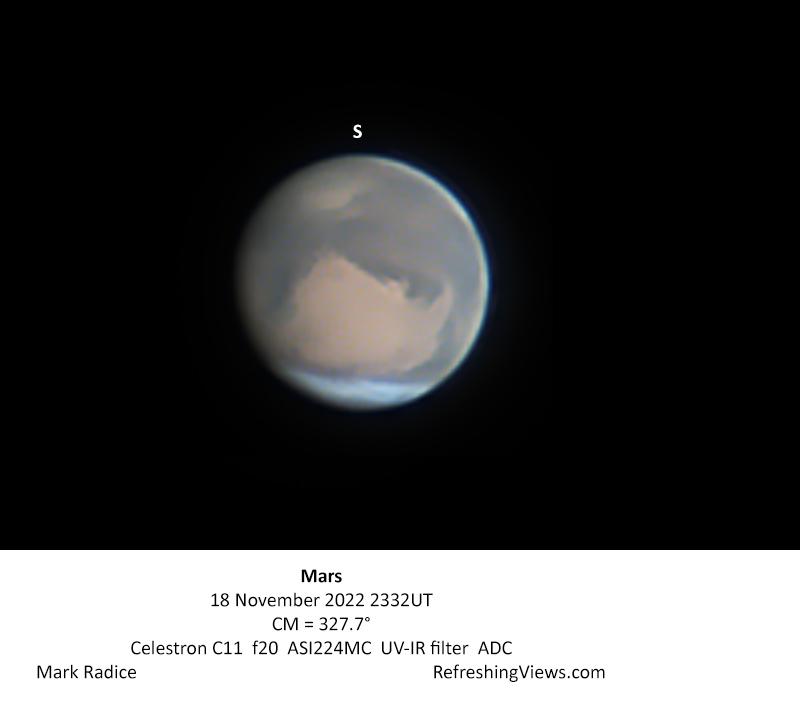
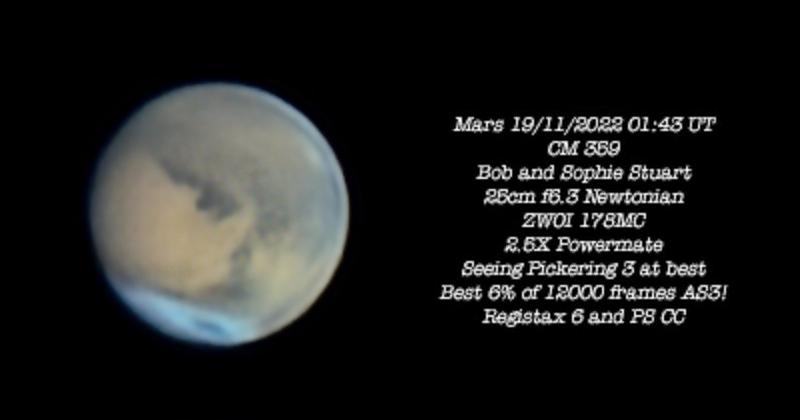
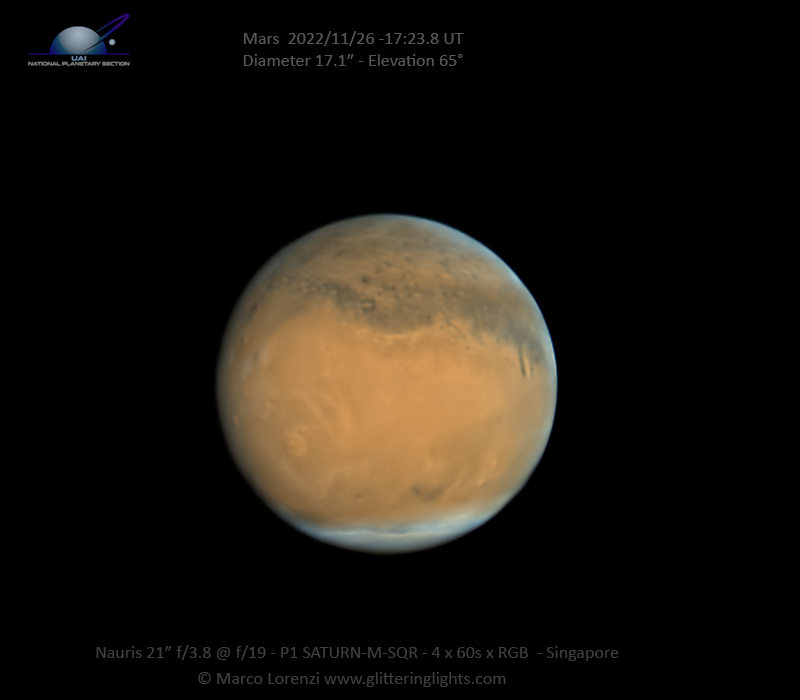
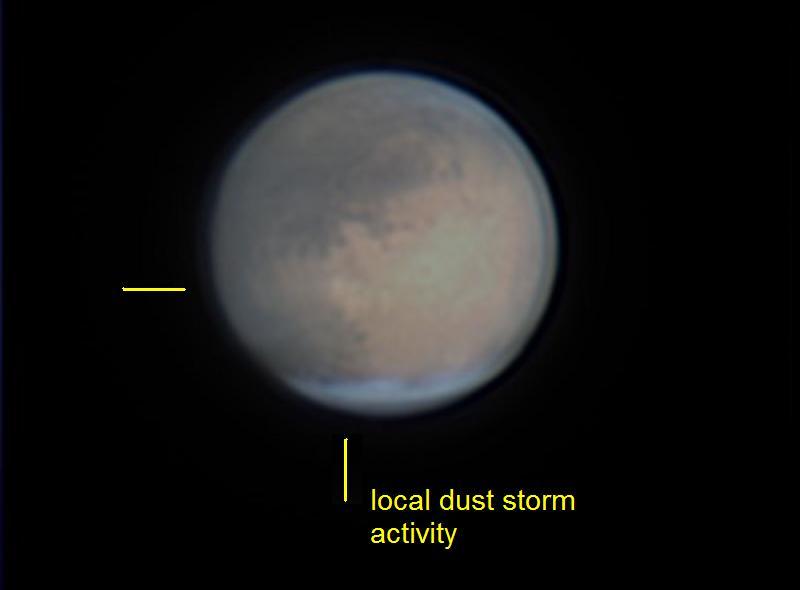
Teaser image by Peter Tickner
Mars Opposition Blog 20 November 2022
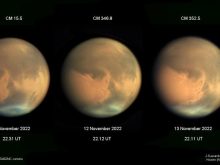
We are now just a short time before opposition. First I want to draw your attention to the occultation of Mars by the Moon on the morning of the day of opposition, December 8. Predicted timings can be found in the BAA Forum post made on November 1 by Alex Pratt, so I won’t give them here. Likewise if you can access Sky & Telescope for October you can look up the article by T.Dobbins and W.Sheehan that predicts the possibility of witnessing some short-term flashes (specular reflections) from the martian surface at the position of the Edom (Schiaparelli) crater: these might be visible from the USA during Dec 3-7 when the latitudes of the sub-Earth and sub-solar points are very close. Short-term series of flashes were seen in 2001 in the north part of the crater, and it is not clear whether the correct combination of circumstances can occur this time when the prediction is for the southern part.
The number of observers has grown steadily and we are now up to over 70 contributors. I have not had time to revise the list posted in an earlier update.
It is now time to watch for and try to time the transition to ground cap, when the polar region will at least become bright in red light. At present there is a complex structure to the hood, and many gaps in it, particularly near the south edge of the hood. See the collage for Oct 31 by N.Phillips, posted here. On Nov 12-13 one of these in the longitude of Mare Acidalium was well seen visually by P.Abel and the Director. There are also numerous bright spots and we give here an image and a polar projection by M.Kardasis from Nov 2. This bright spot was near the crater Perepelkin but the coincidence in position was not perfect. In general the bright spots have been rather changeable.
We have also seen some evidence of returning meteorology after the regional dust storm. Evening clouds have been reported since late last month for example over Arsia Mons (seen by J.Sussenbach on Oct 30, G.Walker on Nov 7 (posted here), etc.). The latter volcano shows two seasonal white cloud maxima. But these clouds are not particularly strong.
The Martian winds have cleared some of the dust deposits on the floor of Hellas. For example on Oct 25 Morales secured an image showing fugitive albedo details in the centre of the basin. The settled dust in Argyre was disturbed by Martian winds causing a small yellowish finger of suspended dust to project north or northwest from the basin. This event was reported by J.Sussenbach (see his image collage for Nov 11-13) and shown in the work of several other European or UK observers including G.Lewis (see his infrared image for Nov 13, suitably annotated and posted here). The Director saw it visually on Nov 12, when it made the N. edge of Argyre appear irregular. It was still apparent on an image received from P.Tickner for Nov 15, as I finish these lines.
Finally, before the phase defect disappears, do watch the evening terminator for any projections due to high cloud, as indicated upon the image by S.Watanabe for Nov 11.
Good luck with the December weather!
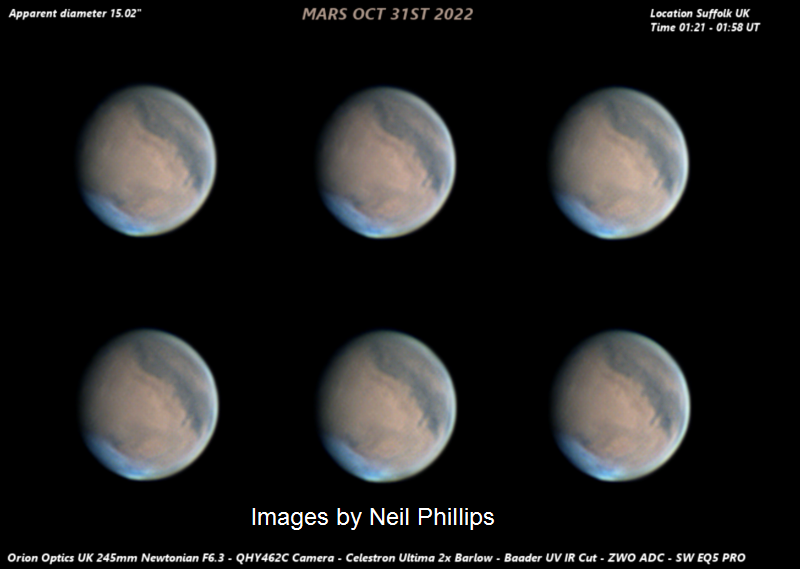
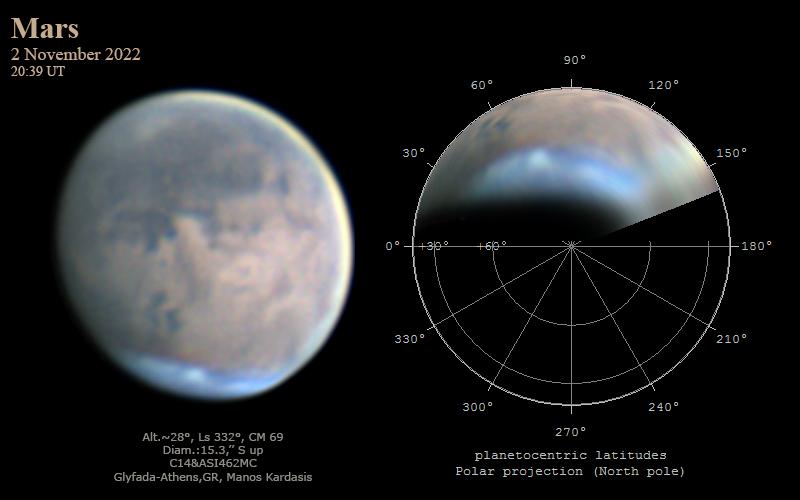
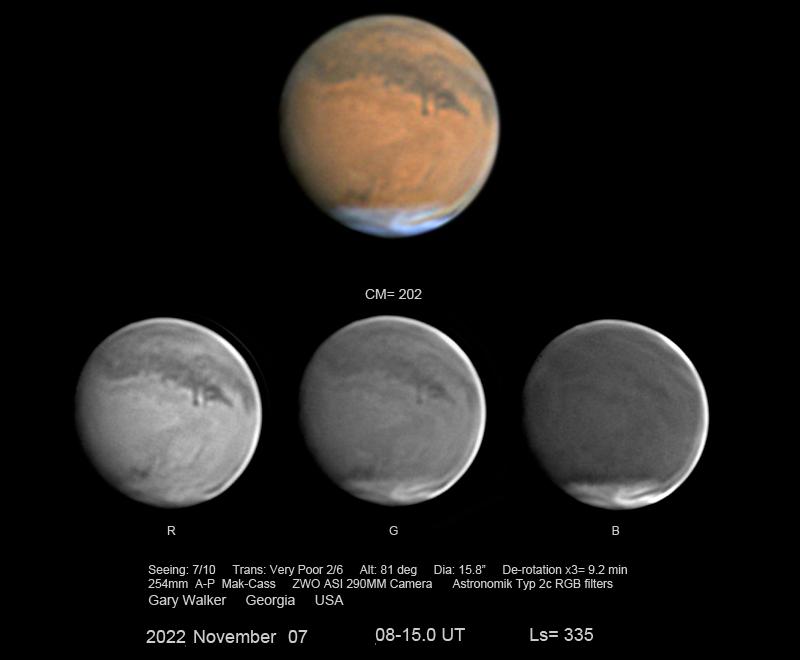
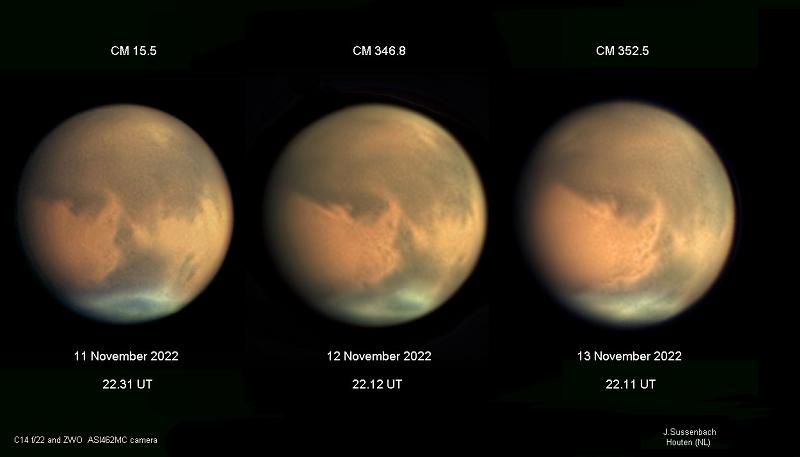
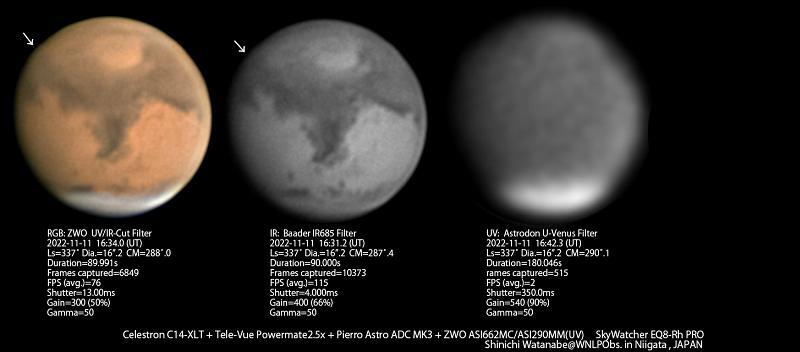
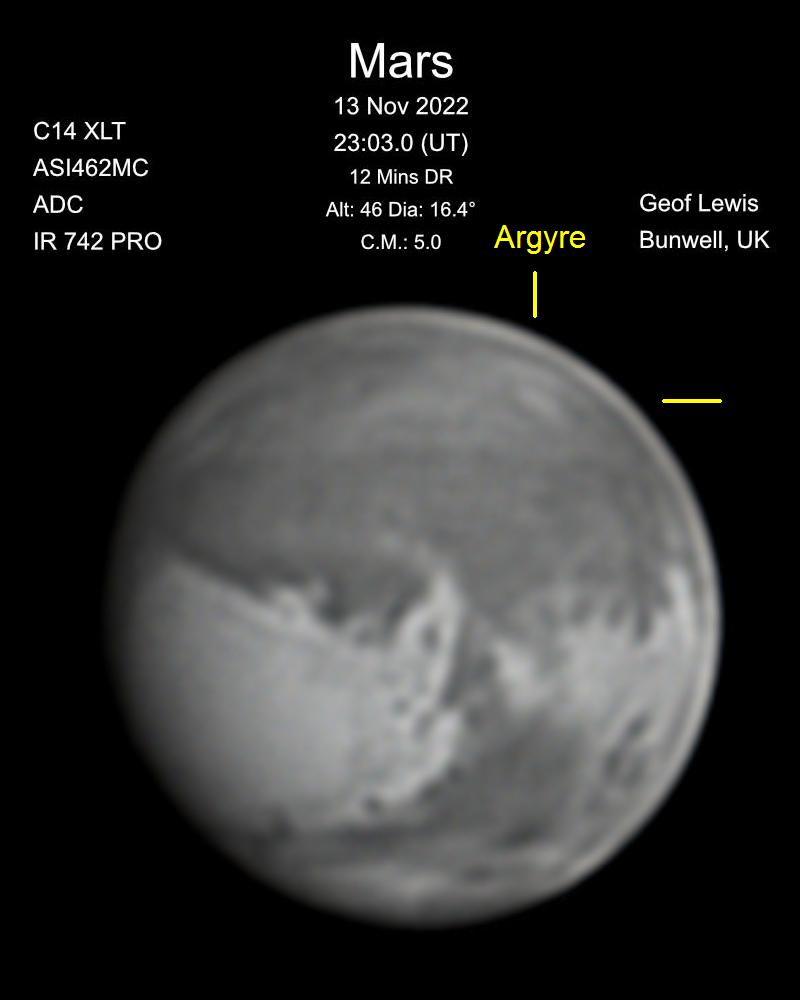
Teaser Image by J Sussenbach
Mars Opposition Blog 10 November 2022
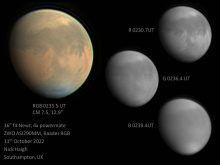
This update covers the period immediately following the recent large regional dust storm, and is complete up till about October 24.
The dust fallout area, located primarily south of Mare Erythraeum (including Argyre), and continuing across Hellas and Noachis to the east, was initially exceptionally large, bright and yellowish-white. By the second week of October there was a distinct core of bright fallout in Argyre amidst a now less bright surrounding area: see the images by Nick Haigh for Oct 11. By Oct 15, Eric Sussenbach’s image showed only the part in Argyre really noticeable as a light area. By mid-month the albedo features were quickly returning to normal, but the Director reminds observers that additional regional level activity is still possible at this season.
A preliminary survey of the data shows that the Oxia Palus-Indus development persists, and indeed Oxia Palus looked more prominent than ever upon some recent images. Pandorae Fretum is now dark, this change having resulted from the storm. Another interesting point is that Phoenicus Lacus shows an extension towards the northwest, as shown in the near-IR image of Oct 12 by Jim Tomney. This is a characteristic but temporary feature of regional and encircling storms affecting this longitude, a fact first noted by the Director during the perihelic opposition of 1988.
A nice comparison with earlier months showing the effect of dust fallout in Hellas, was made by Peter Tickner and is shared here. We remind readers that unless stated, south is uppermost in illustrations.
White cloud activity has not yet restarted; in any case we are now at the seasonal upper limit in the case of the Arsia Mons evening cloud. On the other hand, the north polar hood remains large, bright and complex. It will gradually shrink to leave the north polar cap well by Ls = 360 degrees, the start of N. spring, and we need filter images of the region to be able to date the transition accurately. Watch for any frontal systems moving south off the cap, in the form of inclined bright streaks running Np. to Sf., for these fronts can generate new dust storms (within certain Ls limits).
On Oct 19 Efrain Morales imaged what at first sight appeared to be a tiny projection near the N. limb/terminator. This appearance – as John Boudreau was quick enough to kindly point out when I shared the image with some Section observers in the longitude of the USA – was probably generated by the presence of dark markings (ground and/or shadow) within the north polar hood, coupled with image processing and contrast enhancement. He writes: “With a Declination of the Sun at -14.5° and heliocentric CM of 31.1° at the time of the image, any irregularities along the upper altitude boundaries of the NPH will cast some very long shadows in the north polar region which to me at least, is what these appear to be. I see nothing extending past the outline frame boundary in WinJUPOS measurement. I think Efrain may have clipped his image’s blackpoint enough while processing to have lost any shadow detail. I’ve seen these apparent irregularities in my own images recently.”
I am posting Efrain’s image and John’s projection of it (with north up) in WinJUPOS. It is also true that there have been some very bright discrete clouds and horizontal strips of cloud within the hood lately, and that these might irradiate at the limb. I am grateful to Mike Hood, Frank Melillo, Randy Tatum and Tom Williamson (all USA) in quickly responding with their own images. See the images by Williamson for Oct 20, Hood for Oct 21 and Melillo for Oct 22, which all show a bright belt and/or limb area within the NPH. The same bright areas can be seen on some earlier images and drawings received.
Part 1 of the final report on the 2018 opposition has appeared in the 2022 October issue of the Journal, and the December number will contain part 2. A PDF file of part 1 may now be obtained from our ‘read past reports’ downloads page. As I finish this update I have just corrected the proofs for part 2.
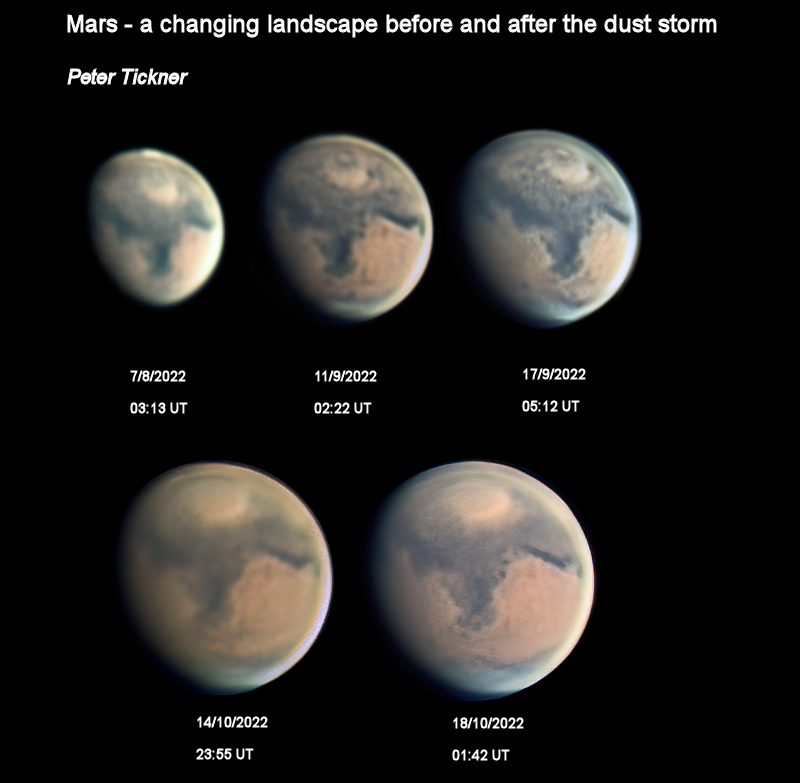
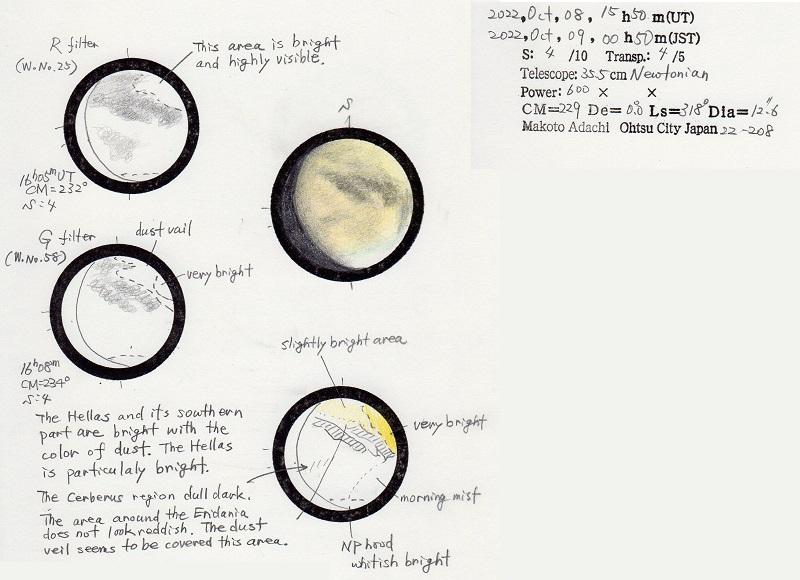
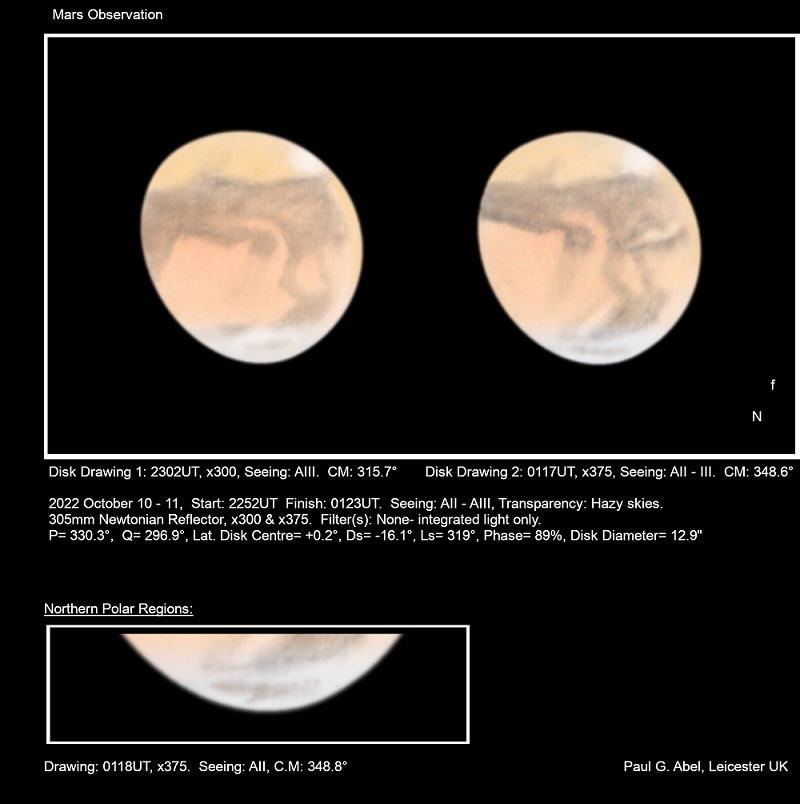
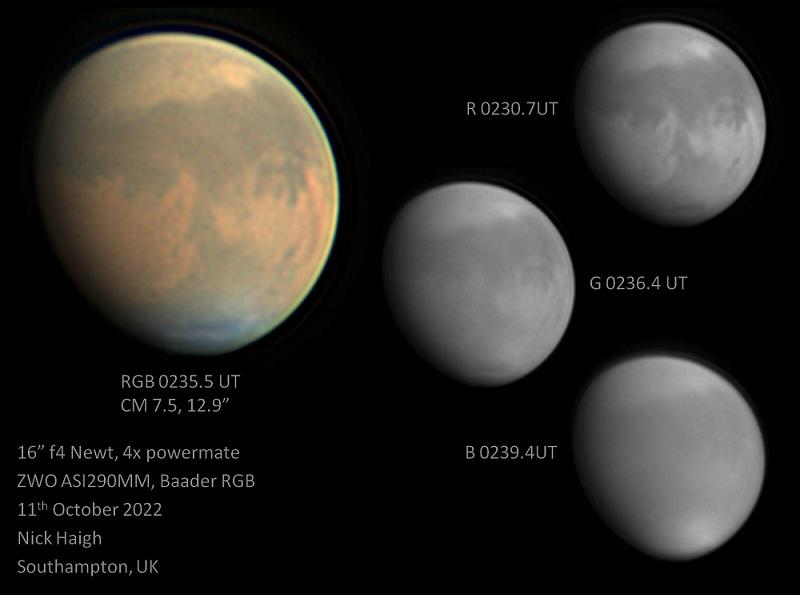
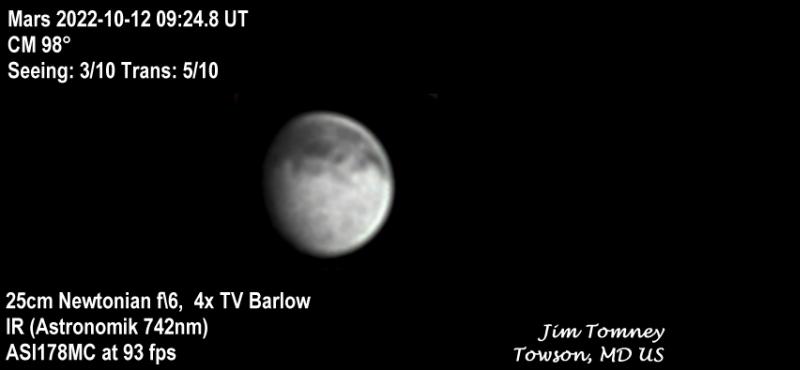
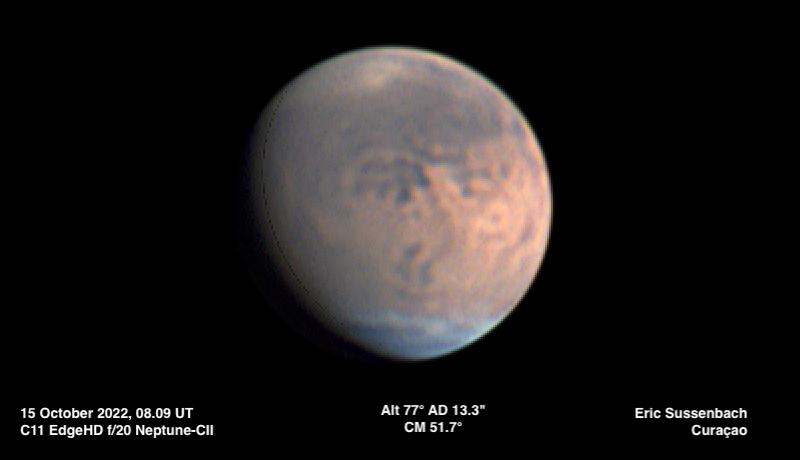
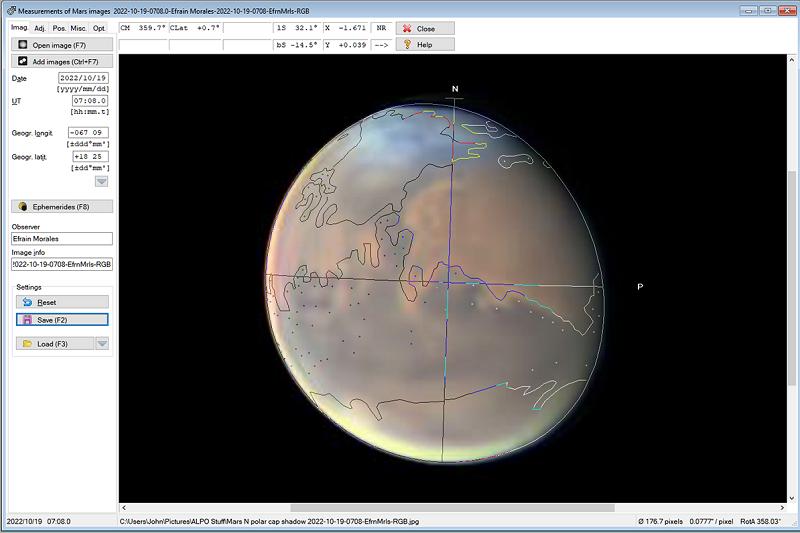
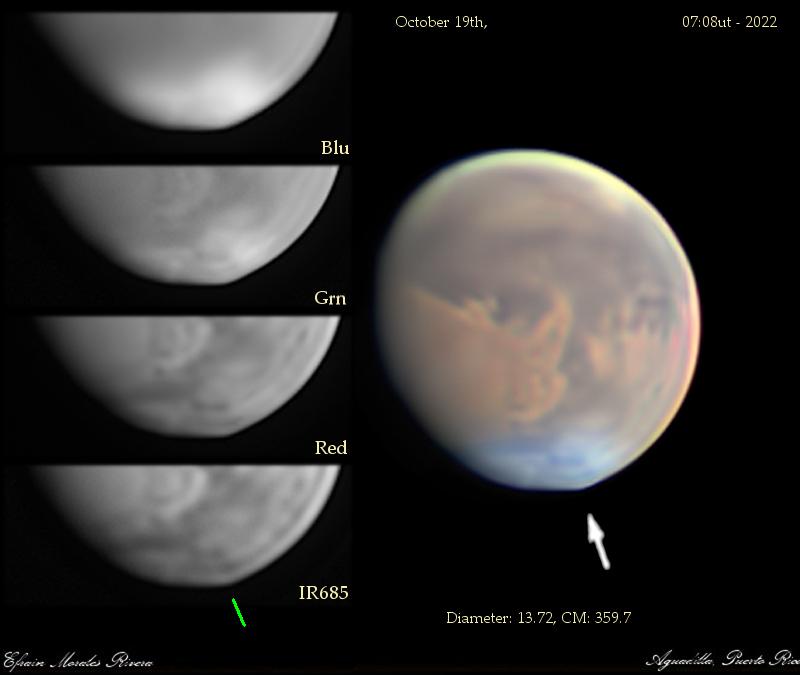
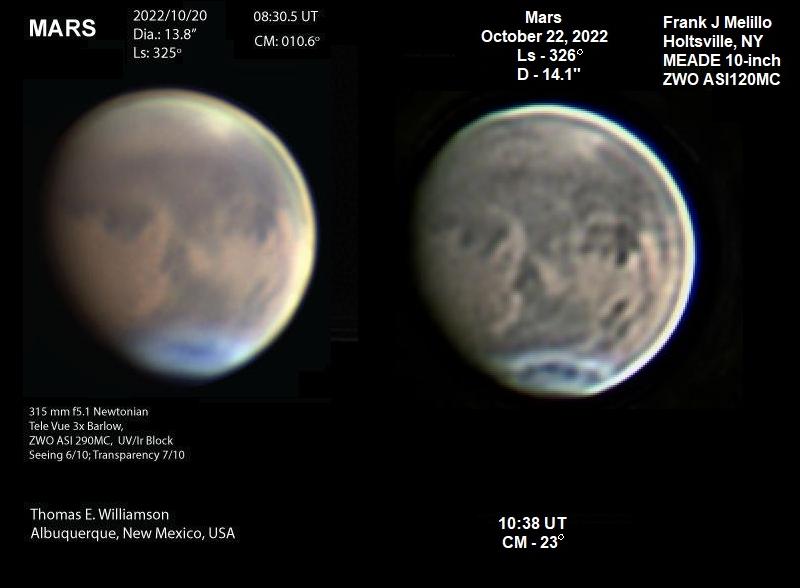
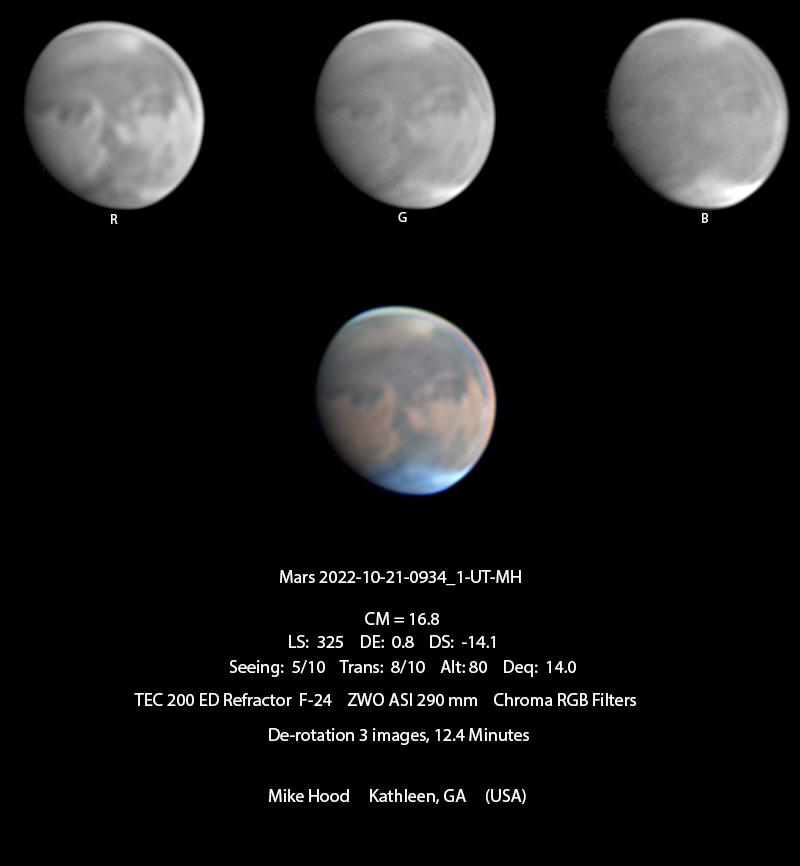
Teaser Image: Mars 2022-10-11 by Nick Haigh
Mars Opposition Blog 16 October 2022
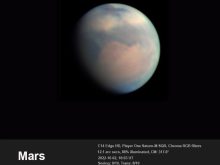
This account, intended to describe the large regional dust storm, covers the period Sep 21 to Oct 3, and slightly overlaps in time with the period of the previous update. It is not intended to be a full account of the event.
On Sep 21 (Ls = 308 degrees) the Japanese observer S.Watanabe imaged a bright yellow local dust cloud in the vicinity of Chryse Planitia. A few days earlier, a band of white cloud elongated Np. to Sf. had been caught moving south from the N. polar region, and it would seem that this frontal system upon crossing Chryse had generated the dust. Not much happened for a few days, but a sudden expansion occurred on the evening of Sep 23 when bright dust had extended all along Vlles Marineris. This was imaged by D.Milika & P.Nicholas (Australia) and seen visually by M.Adachi (Japan). Next morning I at once issued an alert at the BAA Forum, followed by a few later updates, and some observers posted their images in response. I predicted that the event would be a large regional one, like that of 2020 November. The latter event had begun on 2020 Nov 11 at Ls = 313 degrees, and the two storms were rather similar both in seasonal timing and in development. (A full report on the 2020 opposition is waiting for space in the Journal and will appear in print next year. Meanwhile, you can view the 2020 opposition blog at this website.)
Further rapid expansion occurred on Sep 24. Long stretches of bright dust ran to the north into Chryse-Xanthe, to the east over Mare Erythraeum and to the south towards Argyre. A dusty overlying haze began to cover a very large region. On Sep 25 another very bright dust core appeared suddenly at Aram/Margaritifer Sinus, and dust then began to cover Sinus Sabaeus and Noachis, too. Another small core was seen next day in central Pandorae Fretum. Many spectacular images of the storm were taken.
Subsequent expansion was mostly towards the south and east, but on Sep 26 there was also a very bright fresh core centred slightly NE of Solis Lacus. By Sep 29 the cores looked paler, and the albedo markings over those longitudes appeared to be washed out.
Orographic clouds are a good indicator for the presence of atmospheric dust, because warming of the atmosphere ensues and prevents crystal clouds from forming. The evening cloud over Arsia Mons was last seen on Sep 25, although in the absence of the storm it should have remained seasonally active for a little longer. A good image by Bill Leatherbarrow on Sep 28 failed to show it.
By Sep 29 dust had reached the western side of Hellas, and on Oct 1 another bright cloud of dust was seen within Hellas, merging with the Noachis dust and forming a long belt of dust in the S. hemisphere. Depressiones Hellesponticae at the S. edge of this dust belt was suddenly darkened. Some dust reached slightly east of Hellas, and from Oct 1 the east end of the storm could be picked up in images from America, when it was caught right at the morning limb. However, by then the storm looked to be in decline.
Meanwhile, observers from the UK and Europe were able to get a look at the western end. Bill Leatherbarrow and John Saxton (UK) caught it as a large cloud over the SE limb on Sep 28 and 30, when the storm was dying on that side. But on Sep 30 John Sussenbach (Netherlands) caught a small new bright dust core at Gallinaria Silva, which in turn had diffused away by Oct 3. Such occasional activity is responsible for regenerating this little albedo feature.
The unusual thing about the 2022 storm has been the unusually large area of bright yellowish fallout south of Mare Erythraeum and including the region of the Argyre basin. At first sight it looks like a massive south polar hood. At the time of writing the markings in the affected longitudes are beginning to gain in contrast once again. Makoto Adachi, coordinator for ALPO Japan’s Mars Section, has uploaded daily maps of this storm at their website.
This is a preliminary survey only. As fallout clears we may well spot some more albedo changes. Images by Jamie Cooper and Peter Tickner on Oct 3 and drawings by Paul Abel (all UK) on Oct 1-2 already show that the Solis Lacus is apparently altered in shape. Look out for these changes, please! We still need more data, and very few images of the storm were received directly. If I have to download them from websites there will inevitably be delays in getting hold of them for analysis.
With this update I include images by T.Akutsu, O.Inoue, T.Kumamori, N.MacNeill, D.Milika & P.Nicholas, J.Sussenbach, P.Tickner and J.Warell, and a drawing by P.Abel.
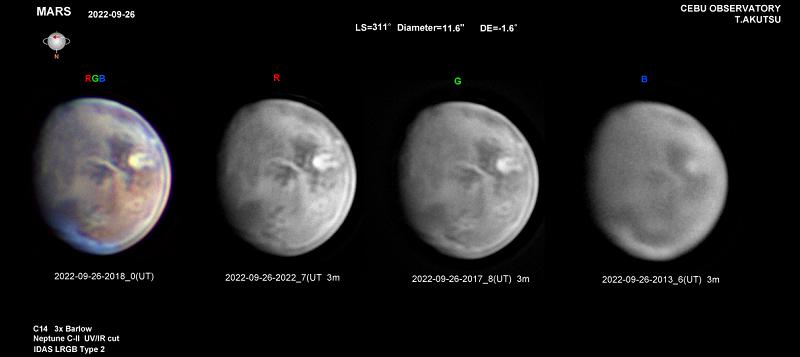
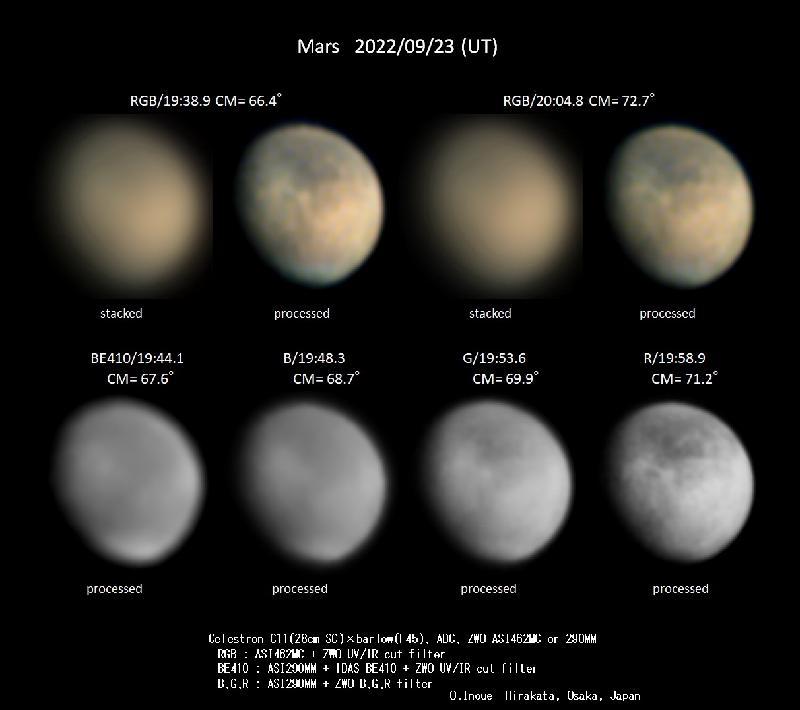
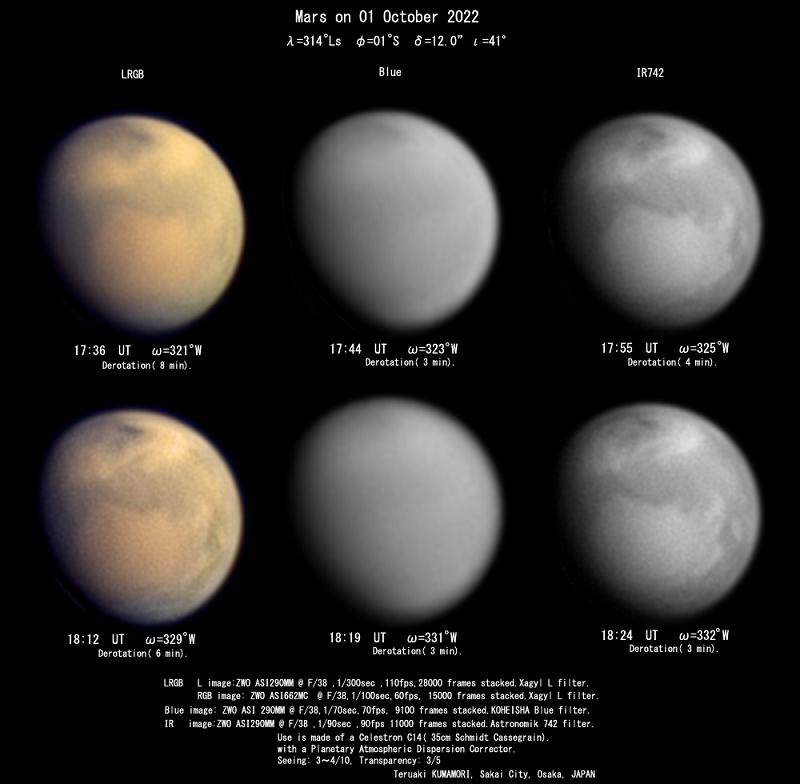
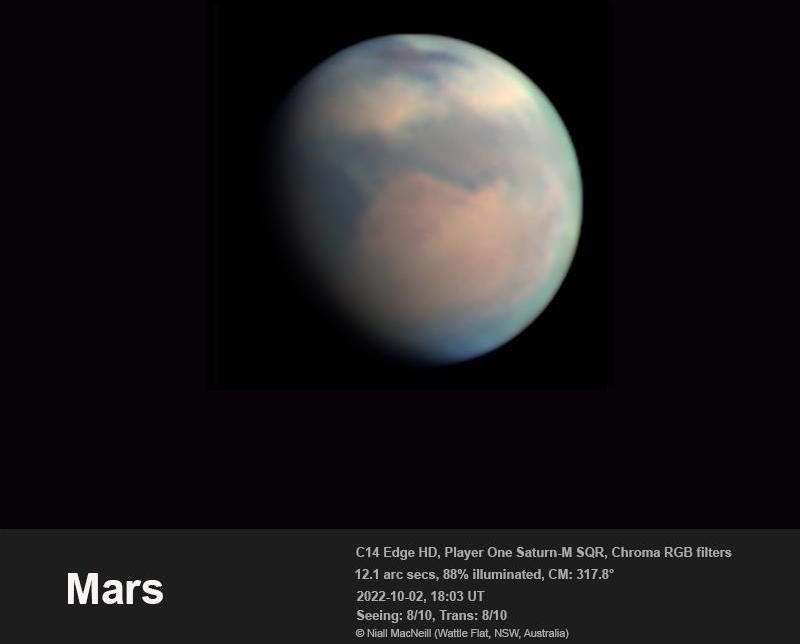
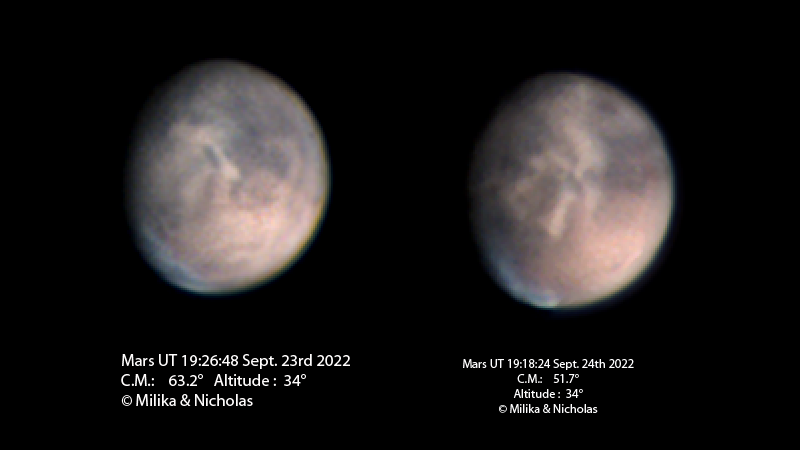
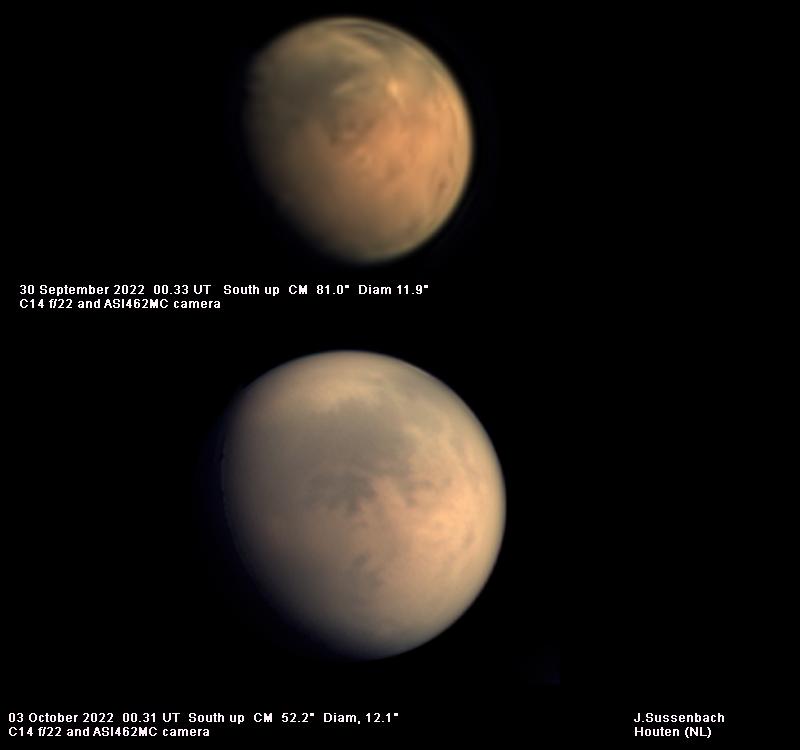
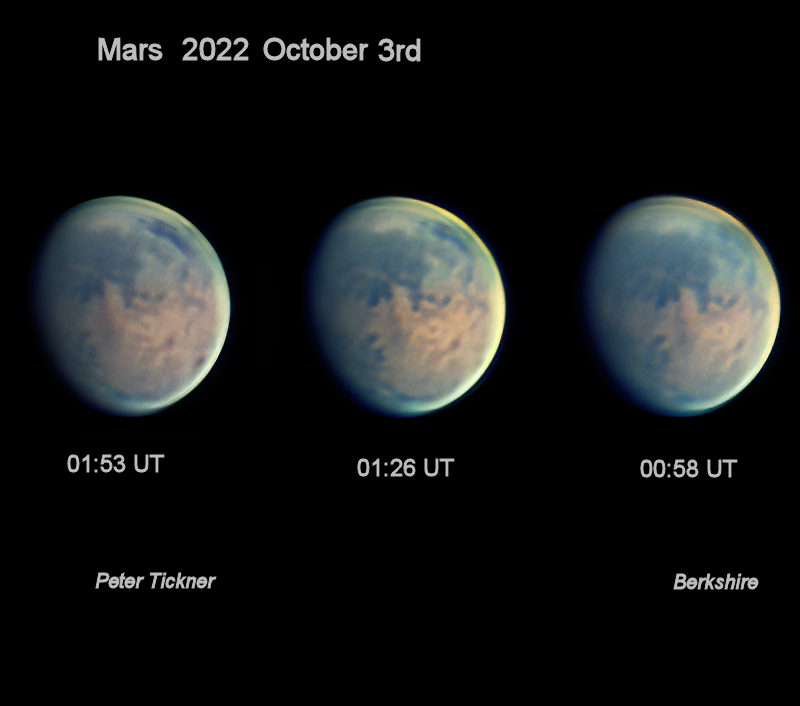
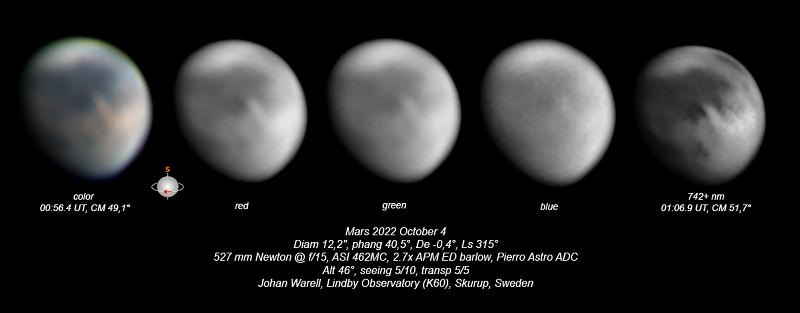
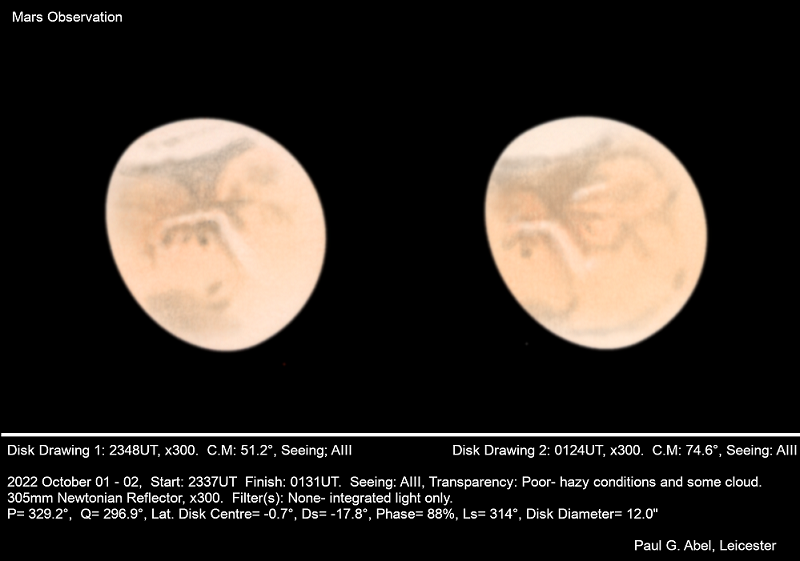
Mars Opposition Blog 2022 October 10
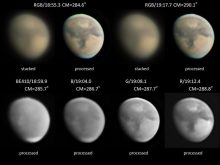
We are updating the Mars blog in two instalments with a short interval between them. First of all, today, one covering the observations up to late September that do not involve the recent large regional dust storm. Second, in a few days’ time, another update will cover that event alone. We have had several old and new observers joining our programme, bringing the total to 52, and the list will be updated later.
John Sussenbach on Aug 24 produced a fine image showing the SPC summer remnant and its unequal division into two parts by the usual seasonal rift at that longitude. Subsequently the S. polar cap became difficult to see, and it was not shown on the majority of later images. Moreover, as I write these lines, the value of the sub-Earth latitude, De, is now no longer negative. (See the BAA Handbook – this is a link for BAA Members only). Mark Lonsdale’s image of Sep 19 is another good one of this longitude, but it does not show the cap.
Observers have been searching the evening terminator for white cloud activity. The Arsia Mons cloud was still well seen, and other clouds to the immediate east and northeast were also imaged (for example by G.Walker on Sep 1). There were also clouds forming in the evening a little to the south of Isidis Regio, running south from Libya and cutting into N. Mare Tyrrhenum, and as far as I can determine they were first recorded by O.Inoue and T.Kumamori from Japan, during Aug 26-30. I have checked through all the other BAA records for August. There are suitable negative observations of that longitude by P.Gorcynski, M.Hood and G.Walker (all USA) on Aug 14-15. Normally one would expect to see these evening clouds slightly more to the north, and centred upon Isidis Regio. You will find them nicely illustrated in our 2005 report, for example (see the ‘past reports’ page).
On Sep 22 Mike Hood drew attention to an isolated circular white evening cloud at or near the crater Briault (-10.5o, 270.5o), and it seems that this little cloud had marked the southern end of the aforementioned evening cloud (which was much longer, in the N-S sense). I cannot recall seeing any evening cloud in that precise location in observations over the past four decades, during the time I have been BAA Mars coordinator. (Briault by the way was just one of the observers who worked for the wealthy French amateur astronomer R.Jarry-Desloges, who now has a nearby crater on Mars and who set up and staffed large observatories in France and Algeria, and published their work in a series of volumes covering the years 1907 to 1941.) A number of observers recorded this little cloud for some time afterwards.
Observations of the bluish, complex and changeable north polar hood again showed several instances of the martian surface being visible through gaps in the cloud. With the change in the sign of De from S. to N. in early October the region will become very well presented, giving way to the ground cap by late northern winter.
By Sep 18, Ls had reached 306 degrees. The seasonally latest global storm known began at Ls = 311 degrees in 1924 December, so there was still a chance that one might begin during this apparition. The next update will show what actually happened.
One final thing: we are not receiving enough observations this apparition, with several well known observers being absent. Data from Japan cover the planet very well indeed, but there could be many more records made from the UK, Europe and the USA.
With this update I am posting images by M.Hood, O.Inoue, W.M.Lonsdale and J.Sussenbach.
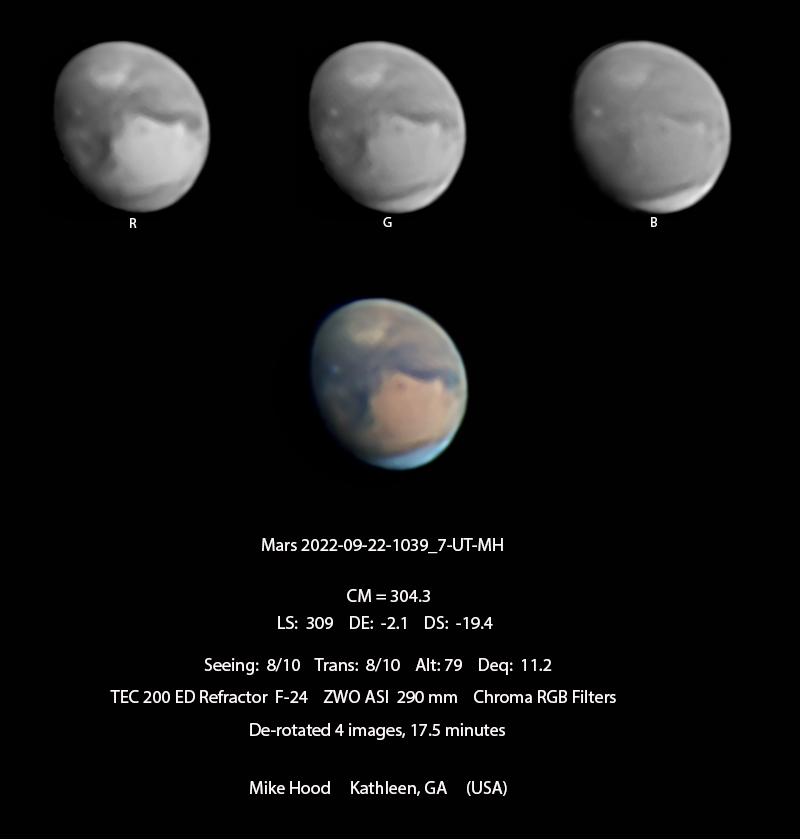
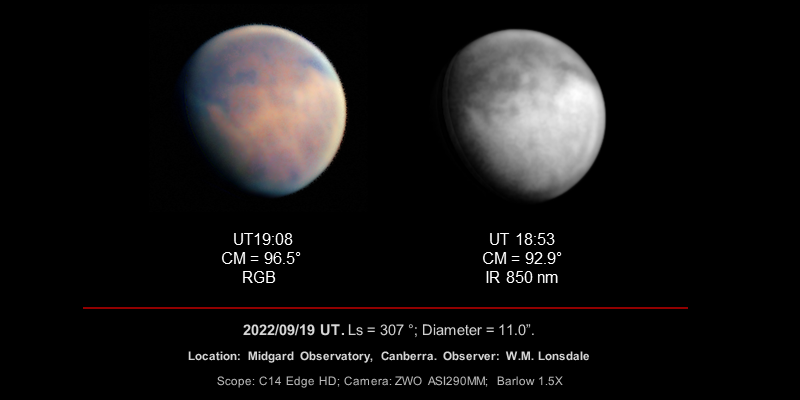
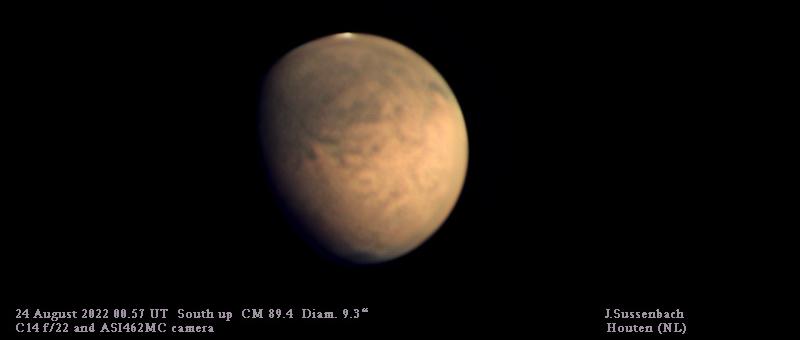
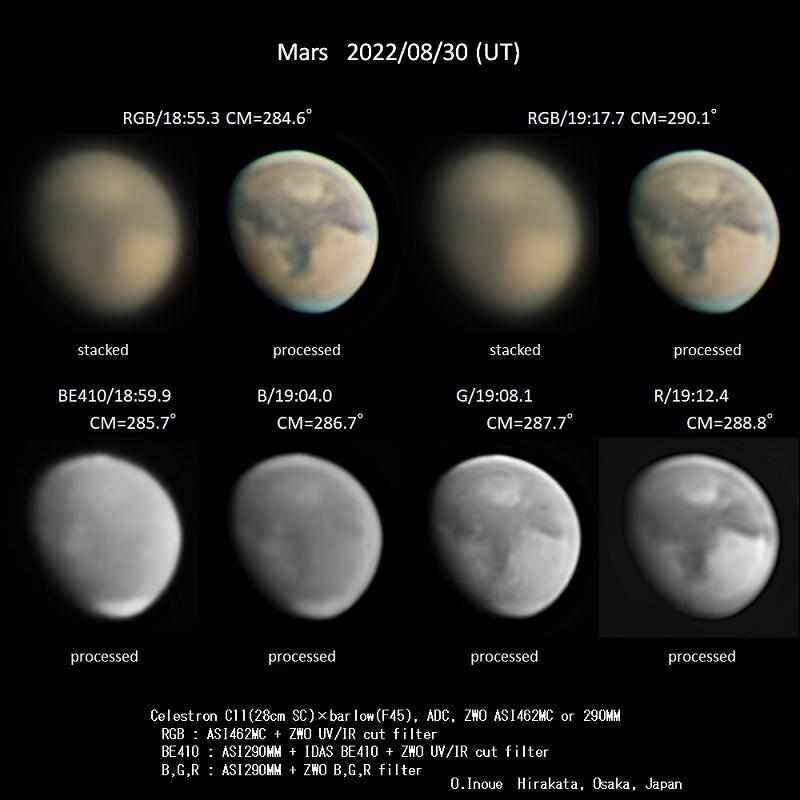
| The British Astronomical Association supports amateur astronomers around the UK and the rest of the world. Find out more about the BAA or join us. |
